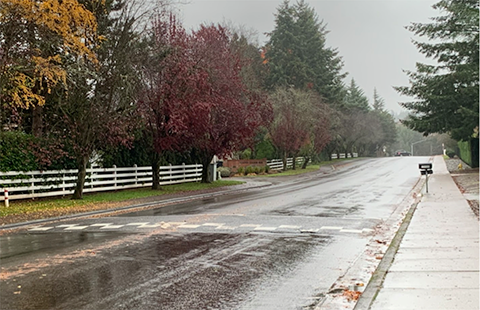Do we have a speed limit problem?

by Cami Villanueva, CMN intern
If you’ve been on local social media, you’re used to seeing complaints of speeding in neighborhoods in the Cedar Mill area. With more people going out to walk around the neighborhood to escape the confines of their home this quarantine, it’s more important than ever that we keep these residential areas safe.

speeders. In general, neighbors have to share the cost of such
measures so few neighborhoods do this.
Some think the roads in the Cedar Mill area, like Saltzman, have too high speed limits considering the amount of pedestrian traffic and closely-spaced intersections. Even residential streets with 25 mph speed limits are seen as too fast in some neighborhoods. Unfortunately, since we are not in a city, there are more steps to changing the speed limits. That’s why we can see some recent speed changes in Portland, but not here. We need to take a step back and wonder if we need to go through the trouble. Saltzman, for example, is 35 mph, sometimes 40 mph in some places. Is the speed limit itself too high, or is there a lack of compliance to the speed limit?

through downtown, and some feel it’s too high.
Options for changing it are limited at this time.
On this ODOT web page there is a way to request a review, but the form must be filled out by a county. If you feel like your neighborhood should be under consideration for lower traffic speeds, first consider going to this web page on the Washington County website where you can learn about and get involved with the Neighborhood Streets Program. This Washington County program brings local residents together to face problems like speeding by trying to implement traffic calming techniques like adding speed signs, providing speed radars, and other ways that create awareness in the community.
By joining the Neighborhood Streets Program you can build a network with Washington County’s Traffic Engineering Department and help find solutions to speeding in neighborhoods without having to go to ODOT and waiting for them to complete their long review process.
We should attempt alternative traffic calming techniques before reducing speed limits because while speed reduction (“20 Is Plenty”) was good for the city of Portland, it isn’t feasible under current state law, and may not be the best option for us. Sometimes, reducing the speed limit only causes frustration, leading to more dangerous behavior. Some ways a neighborhood has tried to reduce speed is by using stop signs and speed humps. For example, NW Burton Street uses speed humps and NW Westlawn Terrace (the street behind the Sunset Mall) has stop signs at every intersection.
Of course, another solution could be you! Set a good example in your neighborhood and other residential areas by driving the speed limit. Or perhaps you mention to your neighbor how speeding is a dangerous problem in the area. Don’t ever blame anyone for the speeding problem, though. More often than not, speeding is an unconscious mistake. That’s why the Neighborhood Streets Program’s efforts to create awareness can be so effective. With your example and input on the problem, you can help give a small reminder to others to keep their speed in mind.
Until changes are made and problems are fixed, pedestrians, please be careful while walking around your neighborhood. It’s important that you go out and stretch your legs, but do it in a safe manner. Walk on the sidewalk (if you have one!) and don’t bike in the middle on the road, especially near street corners/intersections. If it’s dark out, bring a light and/or reflective gear. Though it is the driver’s responsibility not to hit pedestrians, let’s make their job as easy as possible. Together as a community, we can make our roads even safer by being mindful and cautious!
[Ed. Note: We’ll explore changes in Oregon law that may lead to more local control over speed limits in a later issue.]




